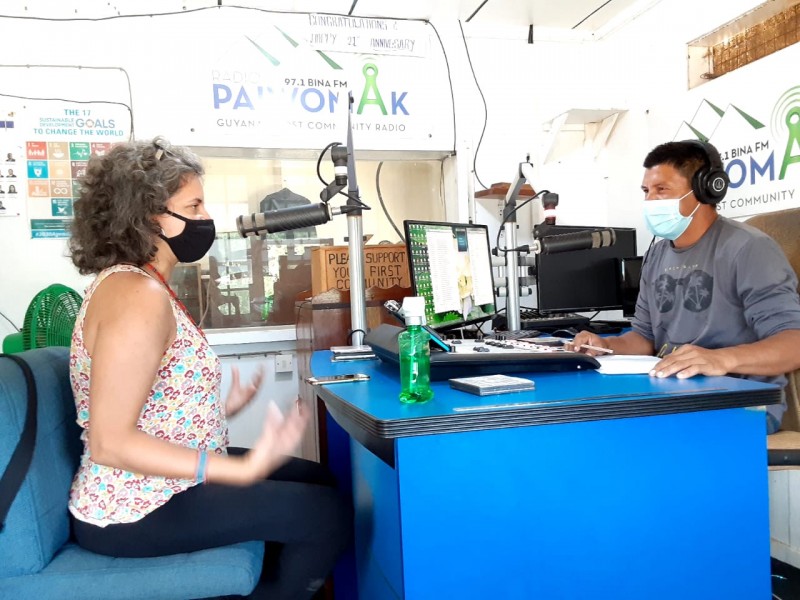Binghamton University Associate Professor of Comparative Literature Giovanna Montenegro first became interested in Guyana and its neighbors while gazing upon a majestic flat-topped mountain called a tepui.
Three South American countries meet at Mount Roraima: Montenegro's native Venezuela, Brazil and the small coastal country of Guyana. The Guiana Shield, as the region's geological formation is called, encompasses parts of Colombia, Venezuela and Brazil, as well as Suriname, Guyana and French Guiana.
A rainforest ecosystem, it boasts some of the greatest biodiversity on earth. Just as impressive is its human diversity, although the region is little known in the United States. Montenegro, also the director of Binghamton's Latin American and Caribbean Studies program, was a little puzzled herself during that 2008 visit.
"I was just really perplexed as to why the border was on top of this mountain," she said.
She finally had the opportunity to see the region from the other side of Roraima - the Guyanese side - during her trip to the region last fall. Selected as a Fulbright U.S. Scholar for 2022-2023, Montenegro will see even more of the Guyanas and Suriname during several short-term trips to the region over two years
Montenegro is conducting research for her second book; her first, on the Germans who colonized Venezuela in the 16th century, will be released in December via the University of Notre Dame Press.

"Basically, the project is about how this whole region of the Guyanas was historicized and represented as a kind of utopia with unlimited natural resources, including gold," she explained. "Part of the project encompasses how the region's Indigenous and Maroon communities are using resources such as colonial maps to figure out the boundaries of their ancestral territories."
In preparation, she is currently spending a month at Chicago's Newberry Library as a short-term Center for Renaissance Studies Fellow to tackle the historical aspects of the project. The independent research library features one of the largest cartographic collections in the world, Montenegro said; she spent a week there last fall, as well as at the Library of Congress, prior to her first trip to Guyana and Suriname.
A colonial legacy
Suriname is Montenegro's first destination under the Fulbright. Although located adjacent to Brazil, the country and its immediate neighbors - Guyana to the left and French Guiana to the right - speak neither Spanish nor Portuguese. French Guiana is still an overseas colony of France, while Guyana was colonized by the British; Suriname was colonized by the Dutch. The region's residents are multilingual, with many speaking Dutch, English and the national creole, known as Sranan Tongo, as well as other Maroon creole and Indigenous languages.
"Suriname is a place where, after the end of slavery, indentured laborers came from Indonesia, where the Dutch had colonies. And then, indentured laborers from present-day India were also brought in, just as they were to Guyana and the British Caribbean, as well as Chinese laborers. It's a really diverse population," she said.
Suriname is also home to six Maroon populations, who are the descendants of formerly enslaved people who escaped bondage and built thriving communities in the forests. Maroon communities - the largest of which is the Saramaka along the Suriname River - have their own legal structures and languages.
During a sabbatical in fall 2021, Montenegro traveled along the Upper Suriname River to the village of Pikin Slee to meet headman Wanze Eduards, who won the 2009 Goldman Environmental Prize with lawyer Hugo Jabini for their efforts to stop logging and mining on their ancestral lands. Under their leadership, communities along the river established the Association of Saramaka Authorities, which filed a petition with the Inter-American Commission on Human Rights.
The court found on the ASA's behalf, and the Surinamese government agreed to implement the court's judgment in 2008. Montenegro wanted to know what has happened since then, she said.
Indigenous and Maroon communities in the region face vulnerability due to the wealth of timber and mineral resources, including gold and bauxite. Oil deposits offshore pose a different threat, especially since the wealth gained from these resources often goes unshared with local communities.
However, participatory mapping - a process that makes visible the association between the land and local populations - has given Indigenous and Maroon communities a new set of tools to safeguard their environment and culture. The process uses both historical maps and new mapping technologies as well as the culture's oral history to advocate for land claims, she explained.
Documents from the colonial era can show where and how specific communities lived, including their territorial boundaries, the resources they had access to and when or how these resources were taken away, she said.
"Primarily, I want to see how these colonial documents are being repurposed in innovative ways by Indigenous and Maroon communities in order to fight for their ancestral lands," Montenegro said. "I think it speaks to larger issues here in the United States and Canada regarding Indigenous claims."







